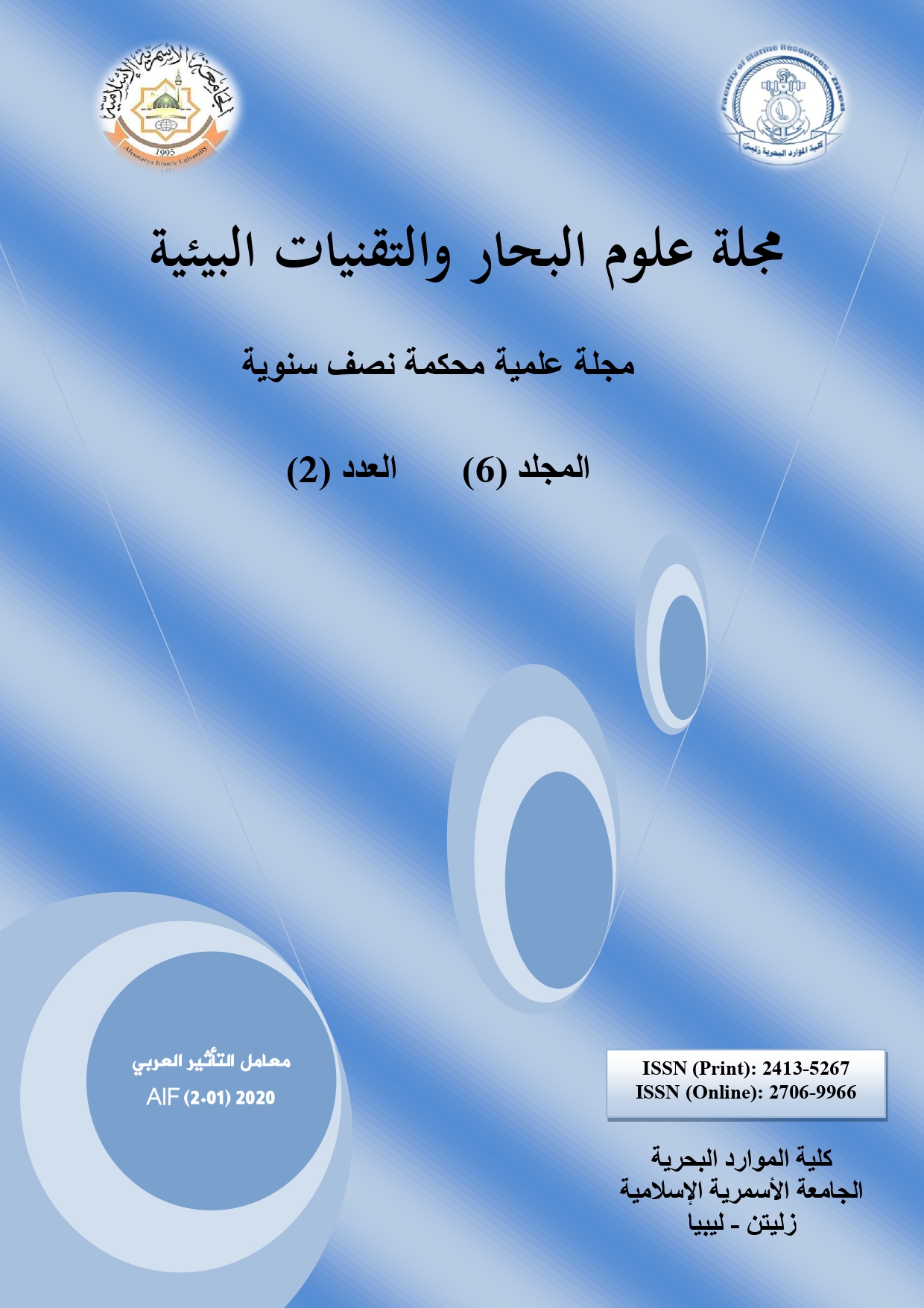التراكم الحيوي للرصاص والكادميوم في بعض الأحياء البرية بوادي الشاطئ، ليبيا
DOI:
https://doi.org/10.59743/jmset.v6i2.41الكلمات المفتاحية:
العناصر الثقيلة، الرصاص، الكادميوم، التراكم الحيوي، الحياة البرية، السلسلة الغذائيةالملخص
استهدفت هذه الورقة تقدير العناصر الثقيلة الأكثر تلوثاً للبيئة (الرصاص، الكادميوم) في الأحياء البرية المتواجدة خارج المدن (الجربوع، القنفذ، الافعى، السحلية، الضفدع، العقرب، الحمام البري، الفار، أرنب، خنفساء، هدهد). واتضح من خلال النتائج أن أعلى التراكيز لكلا العنصرين كانت بين الاحياء اللاحمة حيث تبين تراكم عنصر الكادميوم في السلسلة الغذائية للأفعى بشكل اعلى. وكان أعلى عند تغذيتها على الجربوع (6.95 مجم/كجم). وان أكلات الحشرات كانت تراكم ضعيف حيث كان أعلى تراكم بالنسبة العنصر الكادميوم كانت في الهدهد (0.69 مجم/كجم) من خلال السلسلة الغذائية ويليها القنفذ والسحلية والتي تمثل مستوى ثانوي. واتضح كذلك أن تراكم الكادميوم بمستويات عالية في جسم جميع الاحياء البرية المدروسة على خلاف عنصر الرصاص حيث كانت أعلى نسبة في الهدهد (2.85 مجم/كجم) والحمام (3.39 مجم/كجم) وهذه السلسلة تمثل المستوى الثالث أو الربعة في السلسلة الغذائية لأكلات الحشرات. وكان عنصر الرصاص تراكم ضعيف جداً حيث كانت قليلة جدا في السلسلة الغذائية بالنسبة لأكلات الحشرات في جميع الاحياء المدروسة حيث تبين أن نسبته في الرصاص قليلة جدا لم يتعدى (2 مجم/كجم).
المراجع
أولاً: المراجع باللغة العربية
ابو ضاحي، يوسف محمد؛ اليونس، مؤيد احمد (1988). دليل تغذية النبات. وزارة التعليم العالي والبحث العلمي، جامعة بغداد.
سلمان، جاسم محمد (2007). التراكم الحيوي لبعض العناصر الثقيلة في النبات المائي Myriophyllum verticilatum. مجلة أم سلمي للعلوم الصرفة التطبيقية، 3(4).
كرك، جمال؛ الناصر، عمر؛ شهاب، ثناء (2010). دراسة تراكم بعض العناصر الثقيلة في لحوم سمك الحمري وسمك الكارب العادي في نهر الفرات سوريا. مجلة الحيوانات والدواجن جامعة المنصورة، 12(1).
النجار، غسان عدنان. حنتوش، عباس عادل. ألشمري، احمد جاسب. السعد، حامد طالب (2014). دراسة مستوي التراكم الحيوي لبعض العناصر الثقيلة في اسماك الشانك Acanthopagruslatus المصطادة في السواحل البحرية العراقية. المجلة العراقية للاستزراع العراقي المائي، 11(2).
النعيمي، سعدالله نجم (2000). مبادئ تغذية النبات (مترجم) تأليف منيكل. ك ودي أ. كيربي. مديرية دار الكتب للطباعة والنشر، جامعة الموصل.
ثانيا: المراجع باللعة الإنجليزية
Al-Saad H.T. and Al-Najare G.A. (2011). Estimation concentration of heavy metals in water, sediments and Aspiusvorax fish catching in southern Iraq marshes. Proceeding of the 3rd scientific conference for environmental pollution in Iraq, Iraq environmental protection Association, 3(1).
Canli M., Sorvari J.‚ Rantala L.M.‚ Rantala M.J.‚ Hakkarainen H.‚ and Eeva T. (2006). Heavy metal pollution disturbs immune response in wild ant populations‚ Section of Ecology‚ Department of Biology‚ University of Turku.
Canli M. and Furness, R. W. (1993). Toxicity of heavy metals dissolved in seawater and influences of sex and size on metal accumulation and tissue distribution in the Norway lobster Nephropsnorvegicus. Marine Environment Research, 36: 217–236.
Chan H.M., Trifonopoulos M., Ing A., Receveur O., and Johnson E. (1999). Consumption of freshwater fish in Kahnawake: Risks and benefits. Environmental Research, 80: 213–222.
Koh T.S., Bansemer P.C., & Frensham A.B. (1998). A survey of the cadmium concentration in kidney, liver and muscle of South Australian cattle. Australian Journal of Experimental Agriculture, 38(6), 535-540.
التنزيلات
منشور
إصدار
القسم
الرخصة
الحقوق الفكرية (c) 2020 مجلة علوم البحار والتقنيات البيئية

هذا العمل مرخص بموجب Creative Commons Attribution 4.0 International License.









